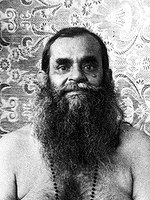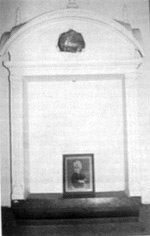History
A brief History : Ramakrishna Math and Mission, Lucknow
by Swami Achyutananda (as published in the Souvenir on the occasion of Platinum Jubilee of the Sevashrama)
With the end of the Sepoy Mutiny the Nawabi era also came to a halt. English took over the reins of several regions in Northern India. To help them in their work, several educated people and senior officials from Bengal travelled out to various regions wherever they were required, some came and settled in Lucknow. Around this time the Great Indian Sage, Swami Vivekananda, took upon himself the task of spreading the message of his teacher-Sri Ramakrishna: That God lives in each human being, so service to man is service to God. With this a new school of thought began to evolve in the late nineteenth century in India. In no time he had a great following especially from amongst the youth of the country.
The first set-ups in Northern India took shape in the religiously historical towns of Kankhal, Varanasi, Vrindaban and Allahabad. Soon Lucknow was touched by the tide of time, a centre sprung up under the leadership of Sarat Chandra Bandhopadhaya. He had a large following of devoted youths who would gather every evening to discuss the paths laid out by Swamiji to relieve his country of misery and pain. What inspired these torchbearers most was that Swamiji had himself travelled through their city on different occasions, on one such occasion, he had reached Lucknow with some of his brother disciples.
Swami Vivekananda reached Lucknow in 1888, while on pilgrimage to Varanasi and Ayodhya. The Islamic culture and history of this ancient Nawabi state had impressed Swamiji to such a great extent that he revisited the place when his followers from Lucknow requested him to spend some time with them. In the summer of 1897, Vivekananda thus broke journey on his way to Kathgodam to be with these friend-followers. Exactly a year later, May 1898, he again visited Lucknow. This time he was on his way to meet the Seviers who had invited him to Almora. This visit is indeed historical as his brother disciples Turiyananda, Niranjananda, as well as his own disciples Sadananda, Sister Nivedita, and Macleod accompanied him.
During this tour Swamiji was acquainted with a local Muslim leader in Nainital, Md. Sarfaraz Hussain. He wrote a letter to Hussain on June 10, 1898 which reveals Vivekananda's belief that synthesis of all religious ideals is the exact essence of India.
Towards the end of the following year Vivekananda once again for the last time halted in this city though for a few hours, during his visit to Mayavati.
It was with these inspiring landmarks, that Sarat Chandra Bandopadhaya had begun the task of serving the people here. He with his men had a tiny shack in Gulab-Niketan, Hewett Road. Not much had been recorded during Bandopadhaya's time. Later many from far and wide were drawn towards the activities of this centre especially when one Brahmachari Biresh Chaitanya took up the missionary work. People say that in all probability it was Sarat who gave up on his worldly life and had been named Biresh Chaitanya.

Atul Prasad Sen
With the passage of time the need for a larger space was felt. At this juncture, an eminent Bengalee Barrister of the city and music lover, Atul Prasad Sen coaxed the city municipality to hand over some worthy place to these monks. An apt place in Aminabad was given immediately to the group and work began with full fervour from this new centre. Today of course save a Shiv temple there stands no relics of this centre; several shops stand in its place. According to Prem Kishore Gupta, an old resident of this locality; "Those who know of the history of this area, still visit it to pay their regards to the old monks who had relentlessly worked to establish this centre." The centre began functioning under a managing committee in an organized fashion since early 1924, when it came to be known as the Ramakrishna Mission Sevashrama. It was then affiliated to its Head Quarters at Belur, in Howrah District, West Bengal in July 1925.
The first records available are from the Accounts details of different centres that are kept at Belur Math. The records of 1924-25 states that a group of dedicated monks are running a centre from Aminabad under the management of a local committee. The records further state that annually there visited 17,628 patients who were attended to in the outdoor unit. Besides, 215 ailing were given financial aid. Both during the communal strife and the floods in Lucknow this group took up immense relief in 1924. A school was also run where free education was imparted during the evening hours to the labourers and their children. Around 24 students from them were also given financial aid to pursue further studies. A small library was set up for the general public within the same premises.
The next records are those available in the records of General Body Meeting of the year 1925-1927. Here the status of the new Sevashrama at Lucknow was publicly announced. It was during these years that for the first time someone from Belur Math was assigned to take up the reins of the work of the Missionary at Lucknow. Swami Deveshananda, popularly addressed as Prabhas Maharaj thus reached Lucknow in July 1925. In the following General Body Meeting records (1928- 1930), the number of patients at the Outdoor clinic increased by a hundred (17728), along with this for the first time an Emergency Department was opened and indoor facility was set up with only two beds.
The next three years witnessed 143 patients visiting the Outdoor clinic daily, whereas 141 patients were attended to in the indoor facility. There were 60 students attending the night school whereas the library had 1377 books. Around this time the local committee was finally set up under the leadership of Swami Sarvananda from Belur Math. Nalini Behari Haldar the then secretary of the committee helped him. Swami Deveshananda continued to work along with the newly appointed Head.

Swami Virajananda
At the annual meeting at Belur, suggestions to have a hospital at Lucknow was taken up in July 1925. A dispensary was started in Aminabad which catered to the medical needs of all irrespective of caste or creed. The generous attitude of the monks here attracted hundreds of patients from all over the city and in no time it popularly came to be known as' Swami-ji- ka dawakhana'; (The Swamiji's Hospital).
Swami Lokeshwarananda (himself a doctor) was especially sent, from Belur Math in 1938, who became extremely popular during his stay in Lucknow. In the following year, May 1939, Swami Virajananada, the President of the Ramakrishna Math and Ramakrishna Mission, Belur, visited the clinic. He was extremely moved and happy, looking at the work of the Sadhus in Lucknow. The Sadhus would spend not less than four to five hours daily attending to each patient personally.

The old shrine at Aminabad
Around this time a library and a school was set up in the same premises. In 1949 Swami Gaurishwarananda (Rammoy Maharaj) was sent as the head of the centre in Lucknow and he served the centre till 1966 when he left for Belur Math. He was a direct disciple of Sri Ma Sarada Devi. His childlike simplicity and love for nature made him a popular Sadhu in no time. Till date he is remembered as one of the most affectionate monks of the Math in Lucknow.
At one time all this appeared almost impossible especially with the kind of problems the monks had to face in Aminabad. With the Sevashram having no outward symbol, people from a different community were planning to build their worship centre in the park right opposite the monastery. Besides violating the municipality rule, this would also mean a source of disturbance to the usual serene and quiet atmosphere that is imperative for the Ramakrishna Math. It was a difficult task to convince these enthusiasts that a temple dedicated to Sri Ramakrishna, Sarada Ma and Vivekananda was present inside the premises that they believed was only a medical centre.

The Shiva Temple at Aminabad
The local devotees came to the support of the monks and quickly constructed a tiny Shiva temple and began to worship it. Rammoy Maharaj remained amazed at this help extended by the devotees, which solved the problem once and for all. Work carried on smoothly thereafter. The Shiva temple since then has been worshipped, till date people believe that this temple has divine powers of removing all hurdles.
During his tenure the Sevashram moved from its 43-year-old abode in Aminabad to Chandganj in the trans-Gomti area. Impressed with the missionary work, the then Chief Minister, Chandrabhanu Gupta, the first Chief Minister of Uttar Pradesh, handed over 4.86 acres of land to the Monks who were all out to serve the people in this area.
After the land was handed over by Chandrabhanu Gupta, construction work of the Vivekananda Polyclinic and the Ashrama gradually gained momentum. The area soon was named Vivekanandapuram. On January 5, 1967, the Sevashram finally shifted here under Swami Sridharananda (Salil Mahraj) who was heading the institute in Lucknow at that time. In June 1970, the President of the Ramakrishna Math and Mission, Helur, Swami Vireshwarananda formally inaugurated the Polyclinic.

Swami Vivekananda
A 14 feet high statue of Swami Vivekananda made out of bronze, by renowned sculptor, Devi Prasad Rai Chaudhury, was installed at the entrance of the Polyclinic in 1977. This imposing structure is different from the conventional ones that are usually copied from photographs. Swami Vivekananda appears to stop here for a while out of this deep concern for the suffering humanity, while on his grand march to eternity. With his face full of compassion, eyes fixed to the Infinite horizon, his right hand slightly raised in benediction and his whole body radiating strength, he seems standing here telling all, "Shiva Gyane Jiva Seva" (Service to man is worship to God).
